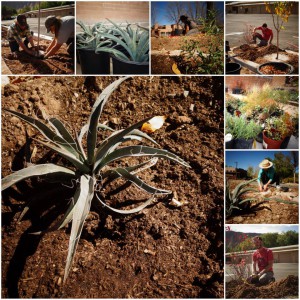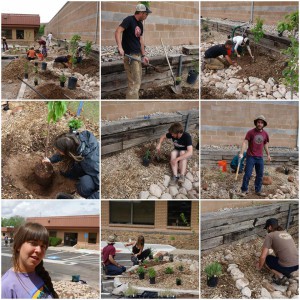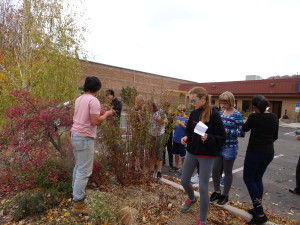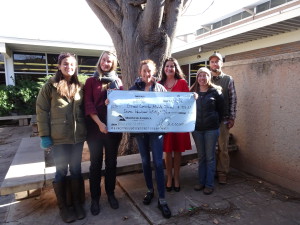There are many Bee Inspired Gardens in the Moab area! These gardens exhibit the traits of: pollinator habitat, water-wise, and food/forage. All of the gardens are slightly different but are are appropriate for their location. The public gardens are listed below. If you are interested in viewing the other gardens, simply find the contact information in the drop down menus. While visiting the gardens, you may gather ideas from them and try similar styles of garden on your own terrain.
PUBLIC
 The Rotary Park was the first official Bee Inspired Garden. The garden was spearhead by Rhonda Gotway Clyde and Kara Dorenwend. The City of Moab takes care of this garden. Bike by and check out this hillside pollinator garden. This garden is open to the public so feel free to stop by and see the garden in person at 680 Millcreek Drive, Moab, UT.
The Rotary Park was the first official Bee Inspired Garden. The garden was spearhead by Rhonda Gotway Clyde and Kara Dorenwend. The City of Moab takes care of this garden. Bike by and check out this hillside pollinator garden. This garden is open to the public so feel free to stop by and see the garden in person at 680 Millcreek Drive, Moab, UT.
News Articles About the Garden:
http://www.moabsunnews.com/news/article_beeea28a-d03d-11e3-b403-0017a43b2370.html
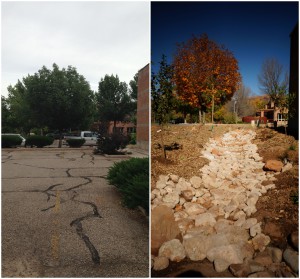 The USU Moab Rain Gardens grew from early collaborations between USU Extension Sustainability coordinator Dr. Roslynn Brain, Utah State University faculty and students, USU Moab Dean Steve Hawks, and a contingent of regional permaculture educators.
The USU Moab Rain Gardens grew from early collaborations between USU Extension Sustainability coordinator Dr. Roslynn Brain, Utah State University faculty and students, USU Moab Dean Steve Hawks, and a contingent of regional permaculture educators.
At Brain’s initiative, an existing parking lot repair project at USU Moab was redesigned to establish an educational garden site focused on water conservation and water management. Brain hired local student Jeremy Lynch as Permaculture Intern, which led to further collaborations with ecological designer Jason Gerhardt and landscape architect Barnabas Kane. Gerhardt’s design firm, Real Earth Design (http://realearthdesign.com/) , was hired to lead a public workshop, coordinated by Lynch, to install a network of rainwater harvesting gardens at USU Moab’s downtown campus in autumn 2014.
With a focus on permaculture principles and regenerative resource management, the USU Moab Rain Gardens are a unique example of how to design landscapes for abundance in the drylands. Designed to be 100% rainwater-fed following establishment, the gardens employ passive water harvesting earthworks – known as swales – to capture and infiltrate rainwater directed into the garden from nearby roofs.
In October 2015, a six-cistern active rainwater harvesting system was installed to provide additional, seasonal water resources. Rainwater held in the 3,180-gallon capacity tanks is used to water plants during seasonal dry spells and drought periods.
An integrated mix of native species and desirable food-producing plants (including 12 fruit trees and several berry shrubs), the USU Moab Rain Gardens highlight the adaptability of agricultural systems to specific climatic needs, while showcasing the history of ethnobotany in the Moab Valley.
This garden is open to the public for viewing and is located at 125 W 200 S, Moab, UT.
If you have questions about the garden or would like to arrange a tour, contact Dr. Roslynn Brain at roslynn.brain@usu.edu.
News Articles About the Garden:
http://www.moabsunnews.com/news/article_9417ad30-af2d-11e3-af13-0017a43b2370.html
http://realearthdesign.com/projects/usumoab/
http://upr.org/post/campus-permaculture-project-gets-exported-moab
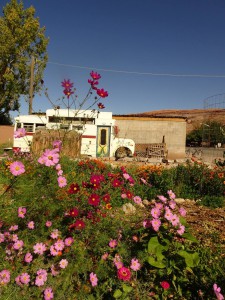 The CommuniTea Garden strives to enhance the Moab community by creating a space that exhibits sustainable land management and development in a way that is inviting for people to stay and enjoy the garden.
The CommuniTea Garden strives to enhance the Moab community by creating a space that exhibits sustainable land management and development in a way that is inviting for people to stay and enjoy the garden. 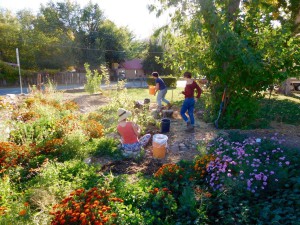
The land is shaped to harvest water to help the many plants growing there, such as fruit trees, herbs, berries, and native plants. Eventually, the trees and herbs will supplement the community with food and herbs for tea.
This garden space is open to the public in the hopes that it will add to the corridor of community-oriented places such as the Mill Creek Bike Path, the Moab Valley Multicultural Center, Swanny Park and the Recreation Center.
All of the materials for the garden were sourced locally and many were ‘upcycled’. The patio is made of used chunks of concrete and tumbled glass from the recycling center. 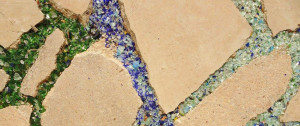
This is an all-volunteer project and we hope that you will contribute your art, talents, and skills to the CommuniTea Garden!
Canyonlands Field Institute (CFI) is an outdoor education center and outfitter based in Moab, UT that has been guiding in the area since 1984. The camp sits at the base of the La Sal mountains in Professor Valley, one of the seven main valleys falling from the mountain. Professor Creek runs through the grounds and empties into the Colorado River only a few hundred yards from the field camp.
The directors of CFI want to have their grounds be educational, functional and beautiful. The ideas of permaculture struck a chord 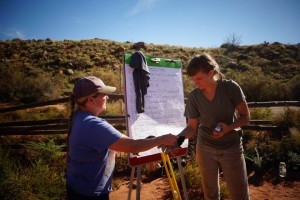 with them and they approached the Bee Inspired Gardens (BIG) crew to design and implement a water-harvesting, dry-land tolerant, pollinator garden. In the Sustainable Communities office, Dr. Roslynn Brain and intern Claire Core took on this project. Dr. Brain was asked to present to a group of doctoral students of Sustainability Education from Prescott College in Arizona about her work with the BIG initiative. The other aspect of the day was to do a service project for the field camp. Roslynn transferred her speaker fee towards buying 60+ native perennial plants from the local nursery and Claire facilitated a group design of the garden. Many of the students were familiar with permaculture, some had taken a Permaculture Design Course (PDC) and one person even taught permaculture at a college. The garden was designed with three infiltration basins that were dug into an area that was found to be at a low point of the grounds, below the septic leach field and that showed that it naturally acquired rainwater at the bottom of a slope. The first basin was a foot deep with a level floor, the next basin was 8 inches deep and the last basin was six inches deep. The basins were connected by rock overflows that were set slightly higher than the previous basin but higher than the next one so that the water would pool in the first basin for a few inches before it would drain into the next basin and the next basin after that.
with them and they approached the Bee Inspired Gardens (BIG) crew to design and implement a water-harvesting, dry-land tolerant, pollinator garden. In the Sustainable Communities office, Dr. Roslynn Brain and intern Claire Core took on this project. Dr. Brain was asked to present to a group of doctoral students of Sustainability Education from Prescott College in Arizona about her work with the BIG initiative. The other aspect of the day was to do a service project for the field camp. Roslynn transferred her speaker fee towards buying 60+ native perennial plants from the local nursery and Claire facilitated a group design of the garden. Many of the students were familiar with permaculture, some had taken a Permaculture Design Course (PDC) and one person even taught permaculture at a college. The garden was designed with three infiltration basins that were dug into an area that was found to be at a low point of the grounds, below the septic leach field and that showed that it naturally acquired rainwater at the bottom of a slope. The first basin was a foot deep with a level floor, the next basin was 8 inches deep and the last basin was six inches deep. The basins were connected by rock overflows that were set slightly higher than the previous basin but higher than the next one so that the water would pool in the first basin for a few inches before it would drain into the next basin and the next basin after that.
The ideals of t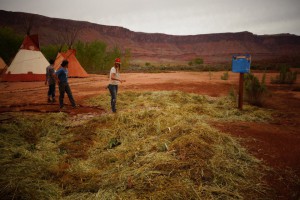 he Bee Inspired Garden fit with the mission of CFI in that at CFI, they have the goals to, “Increase understanding of, connection for, and care for the Colorado Plateau; expand perception of and appreciation for the beauty and integrity of the natural world; Dialogue about issues affecting the public, private and tribal lands of the Colorado Plateau bioregion; and the introduction of a land ethic that includes respect, reverence, responsibility and reciprocity to the natural world. These mission statements convey the broad goal of the Bee Inspired Garden to foster a mindset of considering how our choices and actions affect the natural world and society. The BIG initiative uses bees, a keystone species, to point to a system-wide topic relating to climate change, food security, biodiversity, appreciation of individual bioregions, learning about the native peoples of the area, place history and so much more. These gardens hope to invoke a sense of place. They are also a model that can be used anywhere. We hope that some of the 400 some people who visit the field camp yearly will be inspired by the principles and take the mindset with them to where they live and consider their own home’s bioregion, history and health.
he Bee Inspired Garden fit with the mission of CFI in that at CFI, they have the goals to, “Increase understanding of, connection for, and care for the Colorado Plateau; expand perception of and appreciation for the beauty and integrity of the natural world; Dialogue about issues affecting the public, private and tribal lands of the Colorado Plateau bioregion; and the introduction of a land ethic that includes respect, reverence, responsibility and reciprocity to the natural world. These mission statements convey the broad goal of the Bee Inspired Garden to foster a mindset of considering how our choices and actions affect the natural world and society. The BIG initiative uses bees, a keystone species, to point to a system-wide topic relating to climate change, food security, biodiversity, appreciation of individual bioregions, learning about the native peoples of the area, place history and so much more. These gardens hope to invoke a sense of place. They are also a model that can be used anywhere. We hope that some of the 400 some people who visit the field camp yearly will be inspired by the principles and take the mindset with them to where they live and consider their own home’s bioregion, history and health.
This garden is not open to the public but you can set up a time to view it by contacting CFI at http://cfimoab.org/contact/
You can learn more about the garden by looking at the garden maintenance manual here!
The Youth Garden Project’s garden space is primarily used for cultivating edible plants and hosting youth education programs. However, a portion of our garden space and landscaping incorporates the main principles of B.I.G.
Our office is located in a historic stucco Shafer Home. Around the Shafer Home we have planted natives, low-water perennials, and edible berry bushes. In our B.I.G. garden area we have plants that bloom at different times of the year, plants specifically chosen to thrive in this climate, and it is not uncommon to hear the quiet buzz of bees and other pollinators enjoying this habitat.. We have also been able to split some plants in this area to transplant portions to other areas at YGP—growing the number of plants that pollinators can benefit from.
In addition to pollinator friendly plants in our B.I.G. area, we are harvesting rainwater through the use of rain barrels. We have rain barrels at the end of our gutter downspouts so the water runoff from the Shafer Home is collected and used throughout our entire garden. We made the rain barrels here at YGP with a simple design and reused barrels from a local company.
Additionally, we have a Orchard Mason Bee box in our fruit tree orchard. Mason bees pollinate fruit trees and thrive in an orchard environment. The box is an extremely educational feature in our orchard as many people are not familiar with these wonderful pollinators.
Stop by and visit the Youth Garden Project anytime! You’ll see the B.I.G. sign from our parking lot, but feel free to walk through the rest of our garden space as well!
This garden is visible from the Mill Creek bike path between 400 East and the Grand Country High School.
This garden is open to the public. The garden is outside of the Old Spanish Trail Arena located at 3641 S Highway 191, Moab, UT.
PRIVATE
“Every child’s unique abilities are nurtured and developed through a dynamic, innovative educational experience integrating fundamental academics with science, technology, the arts, and a global perspective.” -Moab Charter School’s Vision
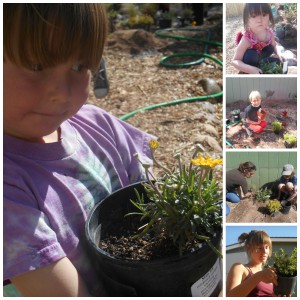
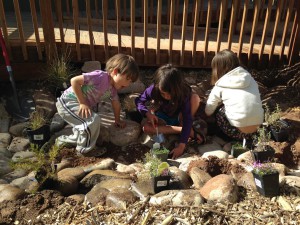 With help from the charter school students, teachers and local volunteers, we have transformed an underused area of the Moab Charter School campus into a highly productive, aesthetically pleasing, educational and sustainable garden. If every teacher is using the garden, in a decade, over 1,000 students will have spent time in the garden. Each student will come out of the school with their own appreciation for taking care of a garden and learning the many lessons it holds.
With help from the charter school students, teachers and local volunteers, we have transformed an underused area of the Moab Charter School campus into a highly productive, aesthetically pleasing, educational and sustainable garden. If every teacher is using the garden, in a decade, over 1,000 students will have spent time in the garden. Each student will come out of the school with their own appreciation for taking care of a garden and learning the many lessons it holds.
The Moab Charter School is a small public school in Moab, serving over 100 students grades K-6. They hold the values of experiential learning, outdoor education, and keeping lessons within the Core Curriculum standards. The charter school was a perfect candidate for the Bee Inspired Garden initiative to partner with. In the spring of 2015, Permaculture Intern Claire Core began organizing towards implementing a garden at the school. This was a hybrid BIG incorporating the help of the Communicating Sustainability class at Utah State University of which Claire was taking the class and brought in her two classmates Ruby Woodruff and Ali Reese and were guided by their professor Dr. Roslynn Brain.
They chose to work with the charter school as their community partner in a community bridge project.
The principal of the Moab Charter School, Emma Weiss, and many of the teachers were interested in having a garden on their grounds. They had recently remodeled their school and now had modular classrooms with space between the classrooms. They had had an annual garden on their grounds before the remodel and were interested in having one again. The issue they had run into with their previous annual vegetable garden was that during the peak of garden production in the summer months, there was no one at the school to take care of and harvest from the garden! We explained that with a native perennial and permaculture-styled garden, they would have less maintenance because the plants are adapted to the cycle of monsoon rains in the late summer and the dryness of other times.
The Moab Charter School garden has been community-supported and driven in every aspect. The school did not have the funds to pay for a garden so a fund-raiser was organized. Over 100 people attended the Pollinator Party, the educational and fun fundraiser. Students created garden-inspired artwork, local beekeepers explained the basics accompanied by an observation hive, there was a honey tasting, face painting, wildflower coloring, a ‘waggle dance’ dance floor, a bake sale, sponsor-a-plant drive, and a silent auction with generous donations from many local businesses. At the event, all of the plants were purchased and enough money was donated that we could buy over 100 plants from our local native plant nursery, Wildland Scapes. Many cubic yards of wood chips were also donated to the garden from Triassic Industries, the closed-loop arborist company in Moab. The wood chips were used as mulch in the planting patches and for the walking path through the garden. A rain barrel was donated by Brian Green of Utah Water Watch and Jeffrey Adams of TerraSophia was of invaluable help through the implementation of the earthworks and installation of the garden.
 This garden, and all Bee Inspired Gardens, use permaculture principles, an ecological design philosophy that looks to the natural patterns of an area to inform that decisions that we make. At the charter school, we noted the sun, wind, and water flows on the site as well as the human use of the site; where the classrooms are placed, how the students use the area, where the nice views are located, concerns of parents and staff members, etc. The location for the garden was selected between the 4th and 5th grade classrooms because it was a large but unused space, it is on the way to the composter, it gets adequate sunlight, is fed by three downspouts, and is visible and accessible to the students.
This garden, and all Bee Inspired Gardens, use permaculture principles, an ecological design philosophy that looks to the natural patterns of an area to inform that decisions that we make. At the charter school, we noted the sun, wind, and water flows on the site as well as the human use of the site; where the classrooms are placed, how the students use the area, where the nice views are located, concerns of parents and staff members, etc. The location for the garden was selected between the 4th and 5th grade classrooms because it was a large but unused space, it is on the way to the composter, it gets adequate sunlight, is fed by three downspouts, and is visible and accessible to the students.
The fundraiser exceeded our expectations and we were able to purchase the plants the very next day and got started on building the earthworks for the garden the next Saturday. The earthworks utilized in this garden were; a raised pathway, wicking the water off the 4 foot wide paths and into the indented infiltration basins also connected to the mouths of the downspouts, feeding the plants in the basins with a long, slow drink of rainwater. The basins are rock-lined which act as mulch, erosion control, create microclimates and are quite beautiful.
This garden was funded and supported by Wabi Sabi’s Make a Difference Grant, Moonflower Community Co-Op, Triassic Industries, and the Moab community.
Claire Core, Ruby Woodruff and Ali Reece of Utah State University’s Communicating Sustainability class, spring 2015, would like to thank the Moab Charter School’s students, staff and community for being supportive partners in the creation of the new pollinator garden.
This garden is not open to the public without school approval. You may contact the charter school to set up a visit time outside of school hours at (435) 259 2277.
Check out the news articles and blog posts about the garden:
http://usuextensionsustainability.blogspot.com/2015/04/moab-charter-school-gets-garden_21.html
Learn more about the garden by viewing the garden maintenance document here!
The Bee Inspired Gardens collaborated with the Aarchway Inn, a locally-owned hotel in Moab, to design and implement a garden that would be beautiful, low-water, enjoyable for the guests and the public, and be an example for other businesses. 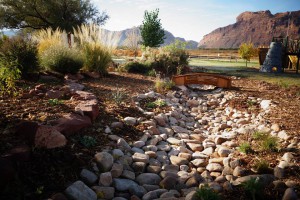
The Aarchway Inn is the first BIG on private land. As a locally owned hotel in Moab, this garden space is an example to the guests of the hotel of how to landscape in an ecologically-conscious way. Their garden space is working on controlling the erosion of the site, uses roof runoff, has appropriate plants for the site, and uses innovative earthworks. We hope that the guests will take away from this garden the inspiration to garden in a water-wise way that is tailored to their own bioregion’s needs.
This garden is open to the public but is off the beaten path. Check out the garden by going behind the Aarchway Inn and west of their pavilion you will find the garden.
News Articles about the Garden:
http://www.moabsunnews.com/get_out_and_go/article_49be51a6-78d2-11e5-848a-8349cf20413c.html
Learn more about the garden by viewing the garden maintenance document here!
Grand County Hospice Garden at the Moab Regional Hospital
The Grand County Hospice has collaborated with the Moab Watershed Council and Bee Inspired Gardens  to install a permaculutre-style pollinator-attracting garden on the grounds of the hospital. It’s near the entrance in a side courtyard. The garden is a memorial garden for the patients of the hospital and hospice to both use in contemplation as well as a place for people to remember lost loved ones. This garden features a fountain from Triassic Industries and many fragrant herbs to create a peaceful and beautiful garden.
to install a permaculutre-style pollinator-attracting garden on the grounds of the hospital. It’s near the entrance in a side courtyard. The garden is a memorial garden for the patients of the hospital and hospice to both use in contemplation as well as a place for people to remember lost loved ones. This garden features a fountain from Triassic Industries and many fragrant herbs to create a peaceful and beautiful garden.
Community Rebuilds Intern Campus
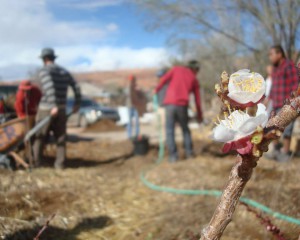 The Community Rebuilds Permaculture Garden began with a generous donation of plants on behalf of Kara Dohrenwend and Wildland Scapes Nursery. Community Rebuilds director Emily Niehaus and student intern Jeremy Lynch collaborated to establish a new garden space at the site of an existing gravel parking lot. A vast understory of native perennials, herbaceous shrubs and flowers, as well as culinary herbs and edibles were set to root before what would prove a long and precipitous winter.
The Community Rebuilds Permaculture Garden began with a generous donation of plants on behalf of Kara Dohrenwend and Wildland Scapes Nursery. Community Rebuilds director Emily Niehaus and student intern Jeremy Lynch collaborated to establish a new garden space at the site of an existing gravel parking lot. A vast understory of native perennials, herbaceous shrubs and flowers, as well as culinary herbs and edibles were set to root before what would prove a long and precipitous winter.
When the snows melted in Spring, the plants returned to life, strong and healthy from a wet winter. In March 2014, a workshop was planned and led by Lillian Hill and Jacobo Marcus of Hopi Tutskwa Permaculture. Lillian and Jacobo taught the students of Community Rebuilds how to build water harvesting earthworks and plant in guilds (a form of co-planting mutually-supportive species in relative proximity). Ultimately, a small-scale food forest was established using the overwintered plants intermixed with food-producing and native trees and shrubs.
Various projects have continued to utilize the Community Rebuilds Permaculture Garden space, including a collaboration with Arizona-based Native Seed/S.E.A.R.C.H. in which indigenously-sourced, regionally-adapted, heirloom vegetables were planted for seed production and seed saving within the food forest.
Every six months, a new crop of 16 Community Rebuilds interns interacts with and learns the management of this unique garden space.
This garden is not open to the public but you can learn more about the garden by contacting Community Rebuilds at http://www.communityrebuilds.org/contactus.html
After visiting the Bee Inspired Garden at Utah State University in Moab, the 8th grade Environmental Science class at Grand County Middle School set to work designing their own pollinator garden in the courtyard of their school.
Last spring the Middle Schools 8th grade Environmental Science teacher Kelly Wilson reached out to the Bee Inspired Gardens about her goal to create a garden as an outdoor learning lab where students could be involved in designing and planting, as well as on-going use of the garden for study and monitoring. Since then Ms. Wilson, Principal Melinda Snow, and other teachers have been collaborating with members of the Bee Inspired Gardens (BIG) group to initiate the creation of a pollinator garden at the school.
Bringing together members from Utah State University Extension Sustainability, Canyonlands Watershed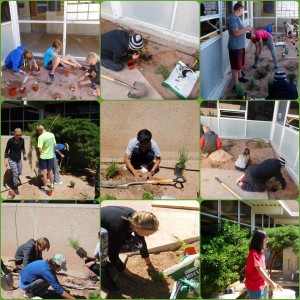 Council, MoaBees, and Youth Garden Project, the Middle School Bee Inspired Garden was planted in the spring of 2017. These organization helped facilitate collaborative approach to integrate the students and school staff into the gardens design, including presentations, field trip, and interactive design sessions.
Council, MoaBees, and Youth Garden Project, the Middle School Bee Inspired Garden was planted in the spring of 2017. These organization helped facilitate collaborative approach to integrate the students and school staff into the gardens design, including presentations, field trip, and interactive design sessions.
The project was awarded a “Make a Difference” grant from Wabi Sabi thrift store and an additional grant from Ag in the Classroom.
The Mayberry Native Plant Propagation Center is a project of Rim to Rim Restoration with the purpose of testing and propagating native plant seeds and containers for regional restoration efforts on public and private lands. Currently Mayberry is growing 1000 regionally sourced (Dolores River, Escalante RIver and near Moab) shrubs and trees for seed production.
In May of 2017, a Girl Scout volunteer group planted the beginnings of the Mayberry BIG Garden. This garden encourages pollinators, and also serves as a testing site for native low-water pollinator plants. 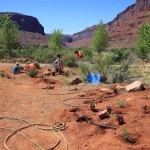
Want some plant ideas? Here are a few helpful local links:
Wildland Scapes list of Shade Trees, Fruit Trees and Evergreens
Wildland Scapes list of Shrubs and Herbaceous Perennials
Wildland Scapes list of Regionally Native Plants


